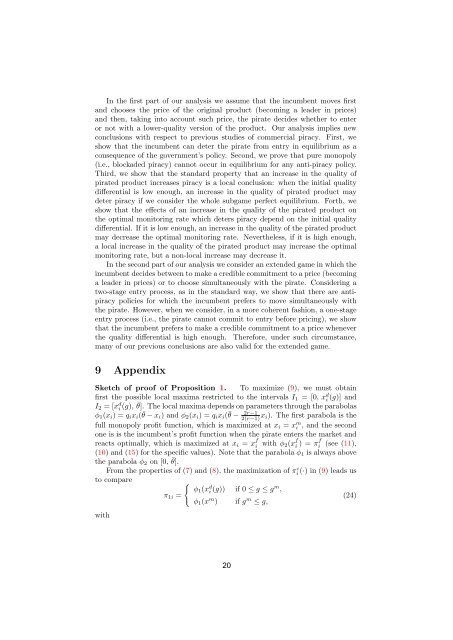Download PDF - Ivie
You also want an ePaper? Increase the reach of your titles
YUMPU automatically turns print PDFs into web optimized ePapers that Google loves.
In the first part of our analysis we assume that the incumbent moves first<br />
and chooses the price of the original product (becoming a leader in prices)<br />
and then, taking into account such price, the pirate decides whether to enter<br />
or not with a lower-quality version of the product. Our analysis implies new<br />
conclusions with respect to previous studies of commercial piracy. First, we<br />
show that the incumbent can deter the pirate from entry in equilibrium as a<br />
consequence of the government’s policy. Second, we prove that pure monopoly<br />
(i.e., blockaded piracy) cannot occur in equilibrium for any anti-piracy policy.<br />
Third, we show that the standard property that an increase in the quality of<br />
pirated product increases piracy is a local conclusion: when the initial quality<br />
differential is low enough, an increase in the quality of pirated product may<br />
deter piracy if we consider the whole subgame perfect equilibrium. Forth, we<br />
show that the effects of an increase in the quality of the pirated product on<br />
the optimal monitoring rate which deters piracy depend on the initial quality<br />
differential. If it is low enough, an increase in the quality of the pirated product<br />
may decrease the optimal monitoring rate. Nevertheless, if it is high enough,<br />
a local increase in the quality of the pirated product may increase the optimal<br />
monitoring rate, but a non-local increase may decrease it.<br />
In the second part of our analysis we consider an extended game in which the<br />
incumbent decides between to make a credible commitment to a price (becoming<br />
a leader in prices) or to choose simultaneously with the pirate. Considering a<br />
two-stage entry process, as in the standard way, we show that there are antipiracy<br />
policies for which the incumbent prefers to move simultaneously with<br />
the pirate. However, when we consider, in a more coherent fashion, a one-stage<br />
entry process (i.e., the pirate cannot commit to entry before pricing), we show<br />
that the incumbent prefers to make a credible commitment to a price whenever<br />
the quality differential is high enough. Therefore, under such circumstance,<br />
many of our previous conclusions are also valid for the extended game.<br />
9 Appendix<br />
Sketch of proof of Proposition 1. To maximize (9), we must obtain<br />
first the possible local maxima restricted to the intervals I 1 = [0, x d i (g)] and<br />
I 2 = [x d i (g), ¯θ]. The local maxima depends on parameters through the parabolas<br />
φ 1 (x i ) = q i x i (¯θ − x i ) and φ 2 (x i ) = q i x i (¯θ − 2r−1<br />
2(r−1) x i). The first parabola is the<br />
full monopoly profit function, which is maximized at x i = x m i , and the second<br />
one is is the incumbent’s profit function when the pirate enters the market and<br />
reacts optimally, which is maximized at x i = x f i with φ 2 (x f i ) = πf i (see (11),<br />
(10) and (15) for the specific values). Note that the parabola φ 1 is always above<br />
the parabola φ 2 on [0, ¯θ].<br />
From the properties of (7) and (8), the maximization of πi c (·) in (9) leads us<br />
to compare<br />
{<br />
φ1 (x d i<br />
π 1i =<br />
(g)) if 0 ≤ g ≤ gm ,<br />
(24)<br />
φ 1 (x m ) if g m ≤ g,<br />
with<br />
18

















